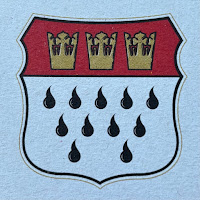Rüdescheim am Rhein, Germany
Of all the surprises that have sprung up before us on this trip, it would be fair to say that none have been as delightful – or remarkable – as the visit to Siegfried's Mechanical Music Cabinet. Rüdescheim is a quaint village in the Rhein river valley, an area that is well known for its production of superb Riesling wines; across the river is the town of Bingen, from which came the medieval mystic, Hildegard. So this little corner of the UNESCO World Heritage river valley has quite the claim to fame.
We'd been told of this historic, ancient house in Rüdescheim, a house whose inhabitants are remarkable pieces of both musical and mechanical genius. This picture on the right shows the exterior of the place; if you look closely, you'll see the glockenspiel perched on either side of the family's crest in the center. It's an indication of what surprises await you when you cross the threshold of this extraordinary temple.
There were original gramophones, ones that played the original, waxed discs (think of the cardboard roll that holds your toilet paper together). A further advance with this gadget was changing the discs and making them flat – what we eventually came to know as LPs – vinyl recordings. Somehow deemed ancient on the part of the curator was a disc with the earliest version of Doris Day's Que Sera, Sera – the whole place ended up singing along! I'll speak more about the gramophone below, for it figures into the history of all the other musical contraptions we witnessed this day.There were armoire-sized cabinets housing an entire array of mechanical instruments that played themselves; this one had a whole collection of organ pipes, a keyboard, even an entire percussion section. Perfectly maintained and serviced, it blew the listener out of the room with both the volume and the breadth of sound that could be produced.
Another cabinet was comprised of nothing but violins – the entire string family of a string quartet, contained in a single box! It was a mechanical engineer's magnum opus come true, because the instruments not only had to be bowed but the plane of the violin needed to be shifted depending on the notes being sounded. To watch this automated wonder at work was just jaw dropping.
So who does the service on these relics? We were told that the mechanics (because that's what they really are) are a dying breed. The waiting time for service is about a decade; the most renowned repairman is now 92 and living somewhere in Switzerland. These are not the kind of apparatus that you can just swing into your local hardware store and pick up a missing bolt for!
One of the last exhibitions was dedicated to something that was ubiquitous in just about every major city in Europe in the middle eighteenth and nineteenth centuries.
These, of course, there were the organ grinders. According to our guide, no less than 800 of these guys roamed the streets of Germany at one point. (You can still see them at the renowned Christmas markets throughout the countryside). The stuffed monkey was there just for amusement, but the instrument was real, a fully restored and working model.
So what ended up being the silver bullet, terminating the legacy of these wondrous mechanical concoctions?
That would be the gramophone. And let's face it, what eventually became the record player was a heckuva lot easier to care for than an armoire full of hardware.... So many thanks to Emile Berliner (and step aside, Thomas Edison).
















